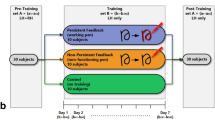Abstract
The use of vision allows us to guide and modify our movements by appropriately transforming external sensory information into proper motor commands. We investigated how people learned visuomotor transformations in different visual feedback environments. These environments presented perturbations of visual sense of movement direction. Across experiments and testing days, we altered the likelihood of visual perturbation occurrence and the distribution of sign and strength of visual perturbation angles. We then observed how transformation of sensed error into incremental adaptation depended on visual perturbation angle and on environmental experience. We found that environmental context affected adaptive responses within a day and across days. The across-day effect was profound enough that people exhibited very weak or very strong adaptive sensitivity to identical stimuli, dependent solely on prior days’ experience. We conclude that trial-by-trial adaptation to visual feedback is not fixed, but dependent on environmental experiences on both short and long time scales.






Similar content being viewed by others
References
Baddeley RJ, Ingram HA, Miall RC (2003) System identification applied to a visuomotor task: near-optimal human performance in a noisy changing task. J Neurosci 23:3066–3075
Burge J, Ernst MO, Banks MS (2008) The statistical determinants of adaptation rate in human reaching. J Vis 8:1–19
Caithness G, Osu R, Bays P, Chase H, Klassen J, Kawato M, Wolpert DM, Flanagan JR (2004) Failure to consolidate the consolidation theory of learning for sensorimotor adaptation tasks. J Neurosci 24:8662–8671
Cunningham HA (1989) Aiming error under transformed spatial mappings suggests a structure for visual-motor maps. J Exp Psychol Hum Percept Perform 15:493–506
Donchin O, Sawaki L, Madupu G, Cohen LG, Shadmehr R (2002) Mechanisms influencing acquisition and recall of motor memories. J Neurophysiol 88:2114–2123
Fernandez-Ruiz J, Diaz R (1999) Prism adaptation and aftereffect: specifying the properties of a procedural memory system. Learn Mem 6:47–53
Fine MS, Thoroughman KA (2006) Motor adaptation to single force pulses: sensitive to direction but insensitive to within-movement pulse placement and magnitude. J Neurophysiol 96:710–720
Fine MS, Thoroughman KA (2007) Trial-by-trial transformation of error into sensorimotor adaptation changes with environmental dynamics. J Neurophysiol 98:1392–1404
Fiorentini A, Ghez C, Maffei L (1972) Physiological correlates of adaptation to a rotated visual field. J Physiol 227:313–322
Hamilton CR, Bossom J (1964) Decay of prism aftereffects. J Exp Psychol 67:148–150
Held R, Hein R (1958) Adaptation of disarranged hand-eye coordination contingent upon re-afferent stimulation. Percept Mot Skills 8:87–90
Huys QJ, Dayan P (2009) A Bayesian formulation of behavioral control. Cognition 113:314–328
Hwang EJ, Shadmehr R (2005) Internal models of limb dynamics and the encoding of limb state. J Neural Eng 2:S266–S278
Joiner WM, Smith MA (2008) Long-term retention explained by a model of short-term learning in the adaptive control of reaching. J Neurophysiol 100:2948–2955
Kagerer FA, Contreras-Vidal JL, Stelmach GE (1997) Adaptation to gradual as compared with sudden visuo-motor distortions. Exp Brain Res 115:557–561
Krakauer JW, Ghilardi MF, Ghez C (1999) Independent learning of internal models for kinematic and dynamic control of reaching. Nat Neurosci 2:1026–1031
Krakauer JW, Pine ZM, Ghilardi MF, Ghez C (2000) Learning of visuomotor transformations for vectorial planning of reaching trajectories. J Neurosci 20:8916–8924
Krakauer JW, Ghilardi MF, Mentis M, Barnes A, Veytsman M, Eidelberg D, Ghez C (2004) Differential cortical and subcortical activations in learning rotations and gains for reaching: a PET study. J Neurophysiol 91:924–933
Malfait N, Ostry DJ (2004) Is interlimb transfer of force-field adaptation a cognitive response to the sudden introduction of load? J Neurosci 24:8084–8089
Martin TA, Keating JG, Goodkin HP, Bastian AJ, Thach WT (1996) Throwing while looking through prisms. II. Specificity and storage of multiple gaze-throw calibrations. Brain 119(Pt 4):1199–1211
Michel C, Pisella L, Prablanc C, Rode G, Rossetti Y (2007) Enhancing visuomotor adaptation by reducing error signals: single-step (aware) versus multiple-step (unaware) exposure to wedge prisms. J Cognit Neurosci 19:341–350
Pine ZM, Krakauer JW, Gordon J, Ghez C (1996) Learning of scaling factors and reference axes for reaching movements. Neuroreport 7:2357–2361
Saijo N, Gomi H (2010) Multiple motor learning strategies in visuomotor rotation. PLoS One 5:e9399
Sarlegna FR, Sainburg RL (2009) The roles of vision and proprioception in the planning of reaching movements. Adv Exp Med Biol 629:317–335
Scheidt RA, Dingwell JB, Mussa-Ivaldi FA (2001) Learning to move amid uncertainty. J Neurophysiol 86:971–985
Seidler RD (2006) Differential effects of age on sequence learning and sensorimotor adaptation. Brain Res Bull 70:337–346
Smith MA, Ghazizadeh A, Shadmehr R (2006) Interacting adaptive processes with different timescales underlie short-term motor learning. PLoS Biol 4:e179
Sober SJ, Sabes PN (2003) Multisensory integration during motor planning. J Neurosci 23:6982–6992
Taylor JA, Ivry RB (2011) Flexible cognitive strategies during motor learning. PLoS Comput Biol 7:e1001096
Thoroughman KA, Shadmehr R (2000) Learning of action through adaptive combination of motor primitives. Nature 407:742–747
Thoroughman KA, Taylor JA (2005) Rapid reshaping of human motor generalization. J Neurosci 25:8948–8953
Thoroughman KA, Fine MS, Taylor JA (2007) Trial-by-trial motor adaptation: a window into elemental neural computation. Prog Brain Res 165:373–382
Tong C, Flanagan JR (2003) Task-specific internal models for kinematic transformations. J Neurophysiol 90:578–585
Valero-Cuevas FJ (2005) An integrative approach to the biomechanical function and neuromuscular control of the fingers. J Biomech 38:673–684
Wei K, Kording K (2009) Relevance of error: what drives motor adaptation? J Neurophysiol 101:655–664
Zarahn E, Weston GD, Liang J, Mazzoni P, Krakauer JW (2008) Explaining savings for visuomotor adaptation: linear time-invariant state-space models are not sufficient. J Neurophysiol 100:2537–2548
Acknowledgments
This work was supported by NIH NS057813 and NSF IGERT training award supporting J. A. Semrau (0548890). We thank M. S Fine, P. A. Wanda, J. A. Taylor, and J. R. Brooks for insightful comments and feedback; and D. N. Tomov for technical expertise.
Author information
Authors and Affiliations
Corresponding author
Rights and permissions
About this article
Cite this article
Semrau, J.A., Daitch, A.L. & Thoroughman, K.A. Environmental experience within and across testing days determines the strength of human visuomotor adaptation. Exp Brain Res 216, 409–418 (2012). https://doi.org/10.1007/s00221-011-2945-z
Received:
Accepted:
Published:
Issue Date:
DOI: https://doi.org/10.1007/s00221-011-2945-z




